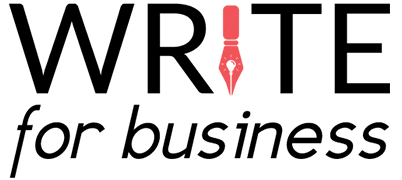B2B Customer Success Stories: How to Write Captivating Narratives
By Helen McCrone, Freelance Content Writer | 1,912 words
Over the years, I've written many customer success stories. They vary in length and style, but they all incorporate the classic triad of challenge, solution and results. There’s no better way to describe a company's expertise and a product's value in a story format. Or is there? I would argue that there is, and it’s called the feature format. Let's take a look.
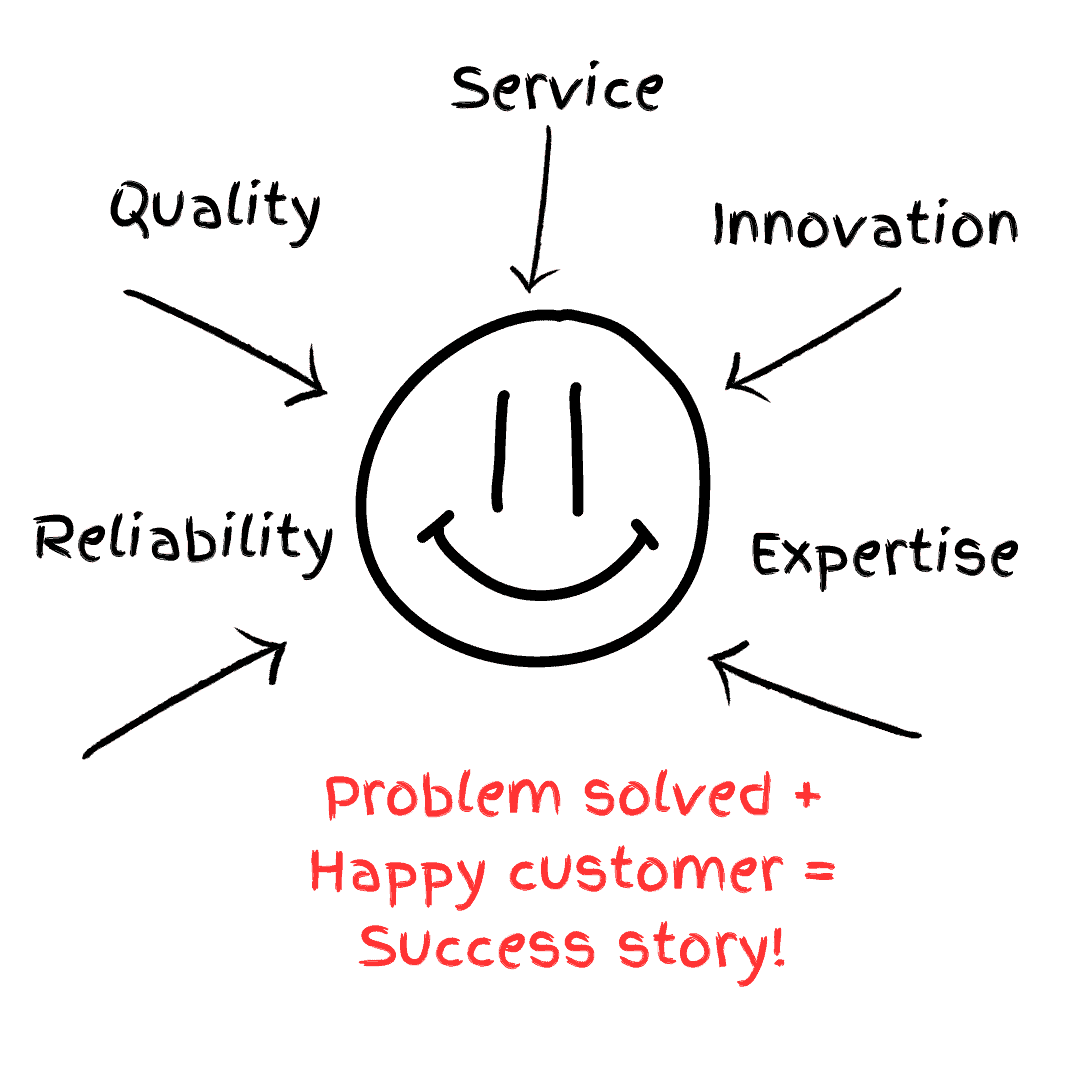
Classic vs. feature format
Let’s be clear from the outset: The feature format is not wildly different from the classic structure that most of us recognize. The elements of challenge, solution and results still make up the bones of the story. What is different is the way the threads of a happy customer's journey are weaved into a compelling narrative.
Adopt the feature format and you can impress and inspire your target audience in the time it takes to read two or three pages. However, just as an artist selects colors and brushstrokes to create a masterpiece, you need to choose the right words and storytelling techniques to illustrate your clients’ problem-solving capabilities.
Sound a little fanciful for your style of marketing? Read on...
The power of storytelling in business
Never underestimate the function of corporate storytelling, even in no-frills industries like engineering, logistics, and manufacturing. Helping potential clients envision their own success stories by reading about the successes of others gives them a good reason to trust you.
We humans are wired to respond to stories. We like to understand how events progress from start to finish because it's how we make sense of information. In short, stories fire up our imagination and teach us to solve problems.
And who doesn't like a happy ending?
Just ask your best salespeople. I bet they have a few favorite stories up their sleeve, ready to pull out whenever they want to engage and enlighten their prospects.
Discover the storyteller inside you
The impact of storytelling, even in the B2B world, is considerable. But if you're not a natural storyteller, turning your customer success stories into a captivating narrative may be beyond your skills.
Or maybe not...
Let me show you the steps you can take to showcase your customer's journey - from challenge to triumph - in a way that immerses your readers in a relatable experience.
Ready to tell a story?
HOW TO WRITE A CAPTIVATING CUSTOMER SUCCESS STORY
A. Find your storyline and cast of characters
1. Discover a suitable success story and pinpoint the angle
Start by finding your happy customers but be selective. You want those who had a recognizable problem that was resolved to their satisfaction and produced measurable results (e.g., more revenue in dollars, time saved in minutes or hours, ROI in percentages, etc.). Industry-wide problems make particularly good stories.
Once you have your story, find the angle and summarize it in one sentence. The angle is what's going to lure people to click and read, so find the one element that will shed new light on the issue at hand. Don't skip this critical step. It will define your story's development.
2. Identify the people who are going to tell your story
Every story needs at least one actor to bring it to life. In the case of business case studies, two actors are preferable: one from your company and one from your customer's company. You'll interview these people later to flesh out the story's details.
Referring to and quoting from real people will enable you to personalize your narrative. Ideally, the person representing your customer should be directly involved in the story and hold a similar position to those you are targeting. Production managers, for example, will find it much easier to relate to another production manager than a CEO or finance manager.
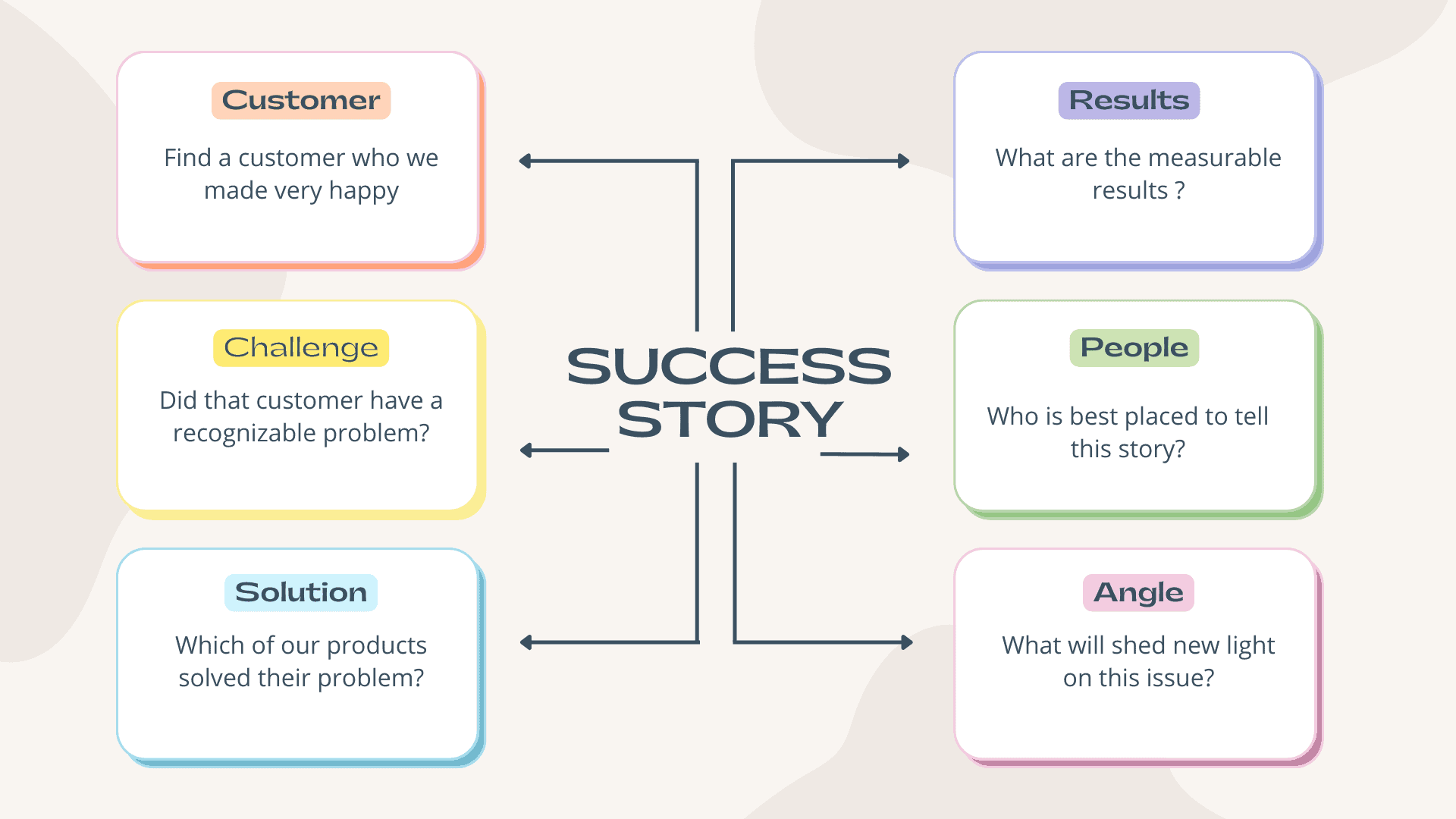
B. Study the subject matter and gather your materials
1. Get a complete understanding of your product or service
Ensure you have all the data you need on your solution, then decide what features and benefits to highlight in the story. Specifications are helpful, but don't overwhelm readers with too much detail.
Give your audience just enough data to understand your product or service and keep jargon to a minimum. They may be knowledgeable, but you don't want to bore or confuse them. You certainly don’t want to distract them from the main story. Instead, add a clear link to a product page or downloadable brochure.
2. Draw up two sets of interview questions and get interviewing
You'll need one list of questions for your colleague and one for your customer. Frame your inquiries to draw out the information you want to elicit from them. (Avoid questions like "How long have you been in business?" You should know this already or can get it from their website.)
Remember, you're crafting a narrative, so ask open-ended questions that require complete answers and try to get a mix of qualitative experiences and quantitative results. Your aim is to get enough material to support your story's angle and insert a human element.
Tip: Always record your interviews (with permission). Recording reduces notetaking and provides you with accurate quotes.
C. Write a compelling headline
1. Grab the readers' attention
All your creative work will go to waste if you can't encourage readers to click on the link to your story. The way to do that is to write a headline or title that tells them they will learn something to their benefit. The word "benefit" is critical here.
People won't bother reading your story if they think they will not profit from reading about someone else's problem. Another tip: write your headline in the present tense to give your story a newsworthy appearance.
2. Be specific and strong
Your headline will be much more convincing if it includes specific results. What sounds more compelling to you: "improves significantly" and "reduces considerably" or "generates extra $1 million" and "shrinks costs by 25%."
If the customer can't give you specific metrics, create a strong headline by avoiding weak verbs. Weak verbs need extra words around them to tell us what's going on, unlike strong verbs, which don't need any help to paint a vivid picture. Compare "helps vs. boosts," "improves vs. energizes," and "cut vs. slash'.
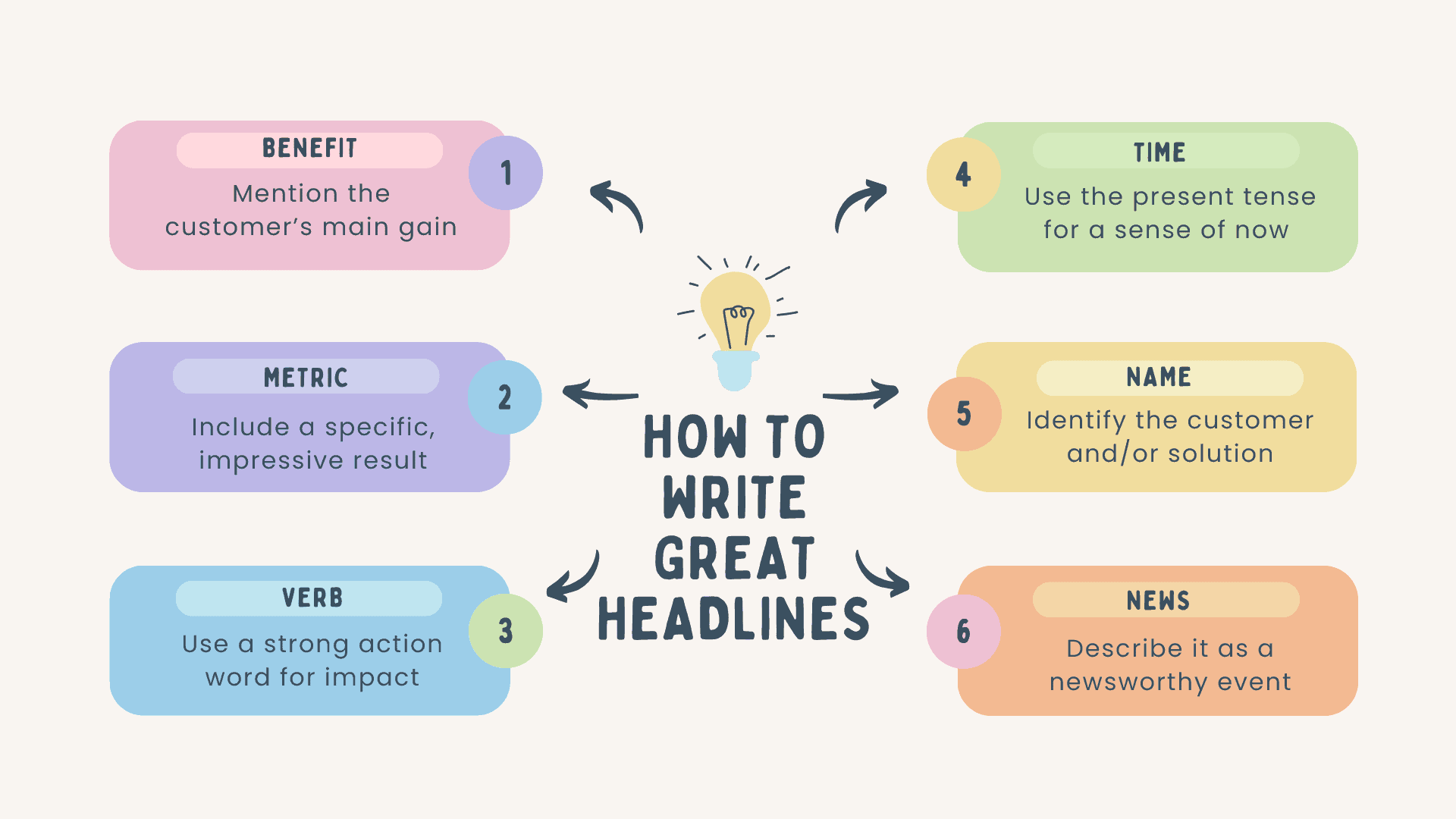
D. Set the scene and present the challenge
1. Immerse readers immediately into the story
All great stories start the same way: by giving readers a vivid sense of when and where the action took place. Business success stories are no different. Introduce the protagonist (your customer), location, and period at the top of the page. Weave in the customer's goals and challenges to make the intro more engaging. Think like a journalist here: use a strong lede or dramatic opening paragraph.
2. Emphasize the impact on the customer's life or business
When describing the challenge, it's not enough to say they were experiencing five hours of production downtime every week. Spell out the consequences, whether it was loss of revenue, delayed customer shipments, or lost business to competitors. Help your target audience identify with the customer's pain.
E. Introduce the solution
1. Acquaint readers with your product or service
Incorporate a few salient specifications. However, remember that this is not a product page. Describe your solution in the customer's environment to add plausibility and help readers picture it in their own factory, office, or warehouse.
2. Showcase your unique selling points
Mention why the customer came to you for help. Did they have a shortlist of vendors, or were you the only company with this solution? What made them choose you over your competitors? This is not the time to be shy.
F. Build anticipation
1. Add a little suspense and curiosity
Borrow some of the techniques a novelist employs. Hint at what could go wrong if the hero (your solution) doesn't work, make readers care about the protagonist (your customer) by voicing their concerns, and strengthen the adversary (the challenge) by describing how formidable it is.
2. Don't give away the ending too quickly
There's no need to insert dramatic cliffhangers at the end of every section of your case study. However, you do want to take readers on a journey. Describe, step by step, how you took your customer toward the solution.
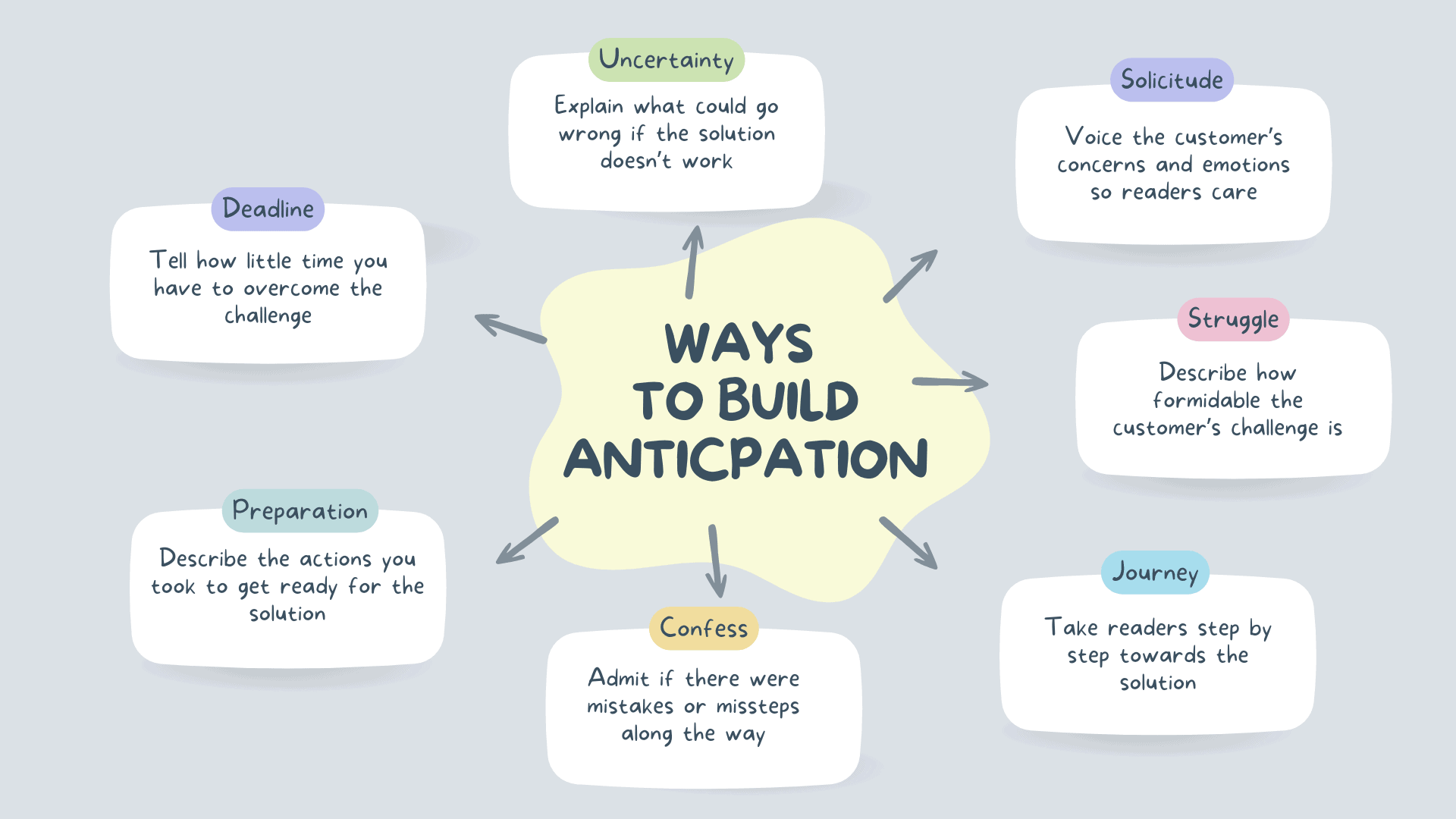
G. Reach the turning point
1. Describe how the customer's life improved
You've overcome the challenge. Now it's time to explain the benefits your customer is enjoying. Make sure you refer back to the goals and challenges outlined in the intro to give readers a sense of closure.
2. Quantify results with specific data or metrics
The more specific you are, the more convincing your case. Metrics and graphs are particularly powerful. Unfortunately, not all customers can provide measurable results. In these situations, highlight the general benefits by laying out each result in bullet form.
H. Come to a resolution
1. Portray the customer's genuine satisfaction
It's time to produce your happy ending. Tell your readers why your customer is so pleased with the results. Ensure you summarize your solution's value and the relationship with your customer.
Reinforce that satisfaction by including a quote that highlights the chief benefit the customer experienced. If the customer has any short- or long-term plans related to your solution, include them here.
2. Insert your story signposts
Signposts help to structure a story. Like signs along a highway, they tell readers where they are and where they're going next. Traditionally, case studies use subheadings like "background," "challenge," "solution," and "results," but they're hardly original or compelling.
As an alternative, use descriptive subheads and one or two sidebars that list the challenges and/or results. These signposts complement the narrative style, support your story's overall message, and help readers skim and scan.
Wrapping it all up
Writing your customer success stories as narratives is an effective way to showcase your company's expertise and demonstrate your product's value. By immersing your readers in a relatable experience, you are much more likely to to make a connection. And that, my friends, will encourage them to learn more about you and maybe even ask you for that demo, quote or consultation.
Need help writing your B2B customer success stories? Check out my case study writing service, then drop me a line at [email protected] for a chat and a no-obligation quote.

